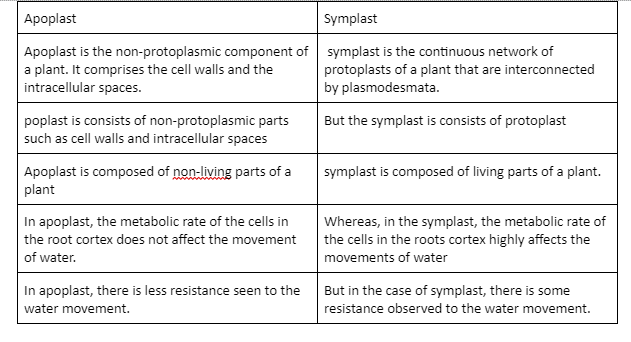The root is the non-greeny part of the plant which grows in the soil and does have nodes and internodes. It is negatively phototropic and positively geotropic. There are two ways the absorption of water by the roots of the plants which include – Active absorption and Passive absorption. Let’s go through the term active absorption and Passive absorption.
Apoplast and Symplast
In the active absorption, the water initially penetrates the cell sap and moves from one cell to another. In this type of movement, protoplasm is needed, this is typically called Symplast. Whereas, in passive absorption, the water goes through the cell walls and intercellular spaces of the roots. The pathway which includes cell walls and intercellular spaces is called Apoplast.
The two unique pathways in plants are – apoplast and symplast. These two initiate the path of water along with ions from root hair through the root cortex to the xylem components. The routes exist either simultaneously or separately having various rates.
Hence, it consists a lot of differences between Apoplast and Symplast. Still, there are few similarities between Apoplast and Symplast.
First, let’s check some of the similarities between Apoplast and Symplast.
Similarities between Apoplast and Symplast
The similarities between apoplast and symplast are interpreted in the three major points –
Similarities between apoplast and symplast pathways
The similarities between apoplast and symplast are interpreted in the three major points –
1.Similarities between apoplast and symplast pathways
Apoplast and Symplast are the pathways by which the water goes from root hair cells to the xylem.
2.Similarities between apoplast and symplast occurrence
Apoplast and symplast both occur in the root cortex to the xylem components.
3.Similarities between apoplast and symplast carrying out
Apoplast and symplast both carry out water and nutrients toward the xylem.
Accordingly, let’s go through the difference between apoplastic and symplastic movement.
The difference between Apoplastic and Symplastic Movement

Conclusion
The root is the non greeny part in plant which grows into the soil and doesn’t not have nodesand internodes which is why there are certainly two ways in which the root of the plantsabsorb water through active absorption and passive absorption. In active absorption, thewater penetrates into the cell sap and moves one cell to another and this type of movementis called symplast. Whereas, in passive absorption, the water goes through the cell walls andintercellular spaces of the roots. The pathway which includes cell walls and intercellular spaces iscalled Apoplast.
 Profile
Profile Settings
Settings Refer your friends
Refer your friends Sign out
Sign out






